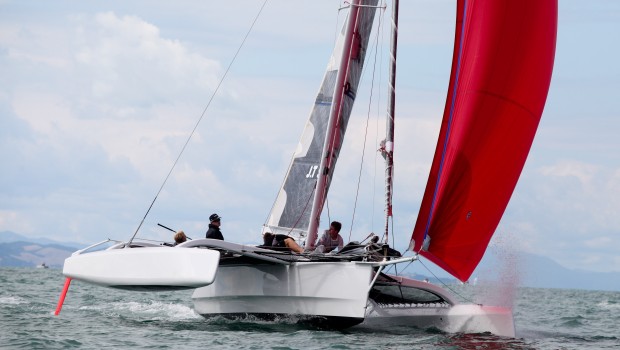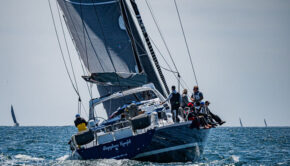Pete Melvin: How Mama Tried ruled the Newport to Ensenada Race
Published on May 4th, 2014
While the Orma 60 Mighty Merloe and the MOD70 Orion garnered the early attention during the 125 nm Newport to Ensenada Race on April 25, it was Pete Melvin’s 8.5 meter trimaran Mama Tried that sailed across the finish line to conquer this California-Mexico contest.
Mama Tried took home three trophies – first place in ORCA Class, best corrected time for a trimaran and the coveted Tommy Bahama Trophy for best overall corrected time of every class.
Knowing Pete Melvin depends on when you knew him. College All-American, Olympic campaigner in 470 and Tornado, A-Class World Champion, and partner in Morrelli & Melvin Design & Engineering.
Most recently Pete is known for his leadership in creating the design rule for the 34th and 35th America’s Cup, and for being a member of the design team for challenger Emirates Team New Zealand during the 34th America’s Cup.
But Pete remains a sailor. Here he provides background on his boat and how it ruled the race…
In 2012, while in NZ working for Emirates Team New Zealand, I decided to buy an 8.5 meter multihull class boat so that I could race and cruise with my wife and three sons. We looked at a few boats and decided that we preferred a trimaran configuration over a catamaran, mostly due to the limited interior space in the 8.5 m (28’) cats. This was to be our cruising yacht for our stay in NZ!
We looked at a few boats and liked a trimaran designed by John Tetzlaff (JT) and Tim Clissold and built by JT for his own use in 2010. We negotiated a deal that included JT building some new floats that I would design. I wanted to increase the volume of the floats and also experiment with some hull shape concepts that I had been thinking about.
We launched the newly modified boat – Mama Tried – in January 2013 and sailed her for four months before I went to San Francisco for the America’s Cup with ETNZ. We had a great time with the boat in NZ, sailing in Wednesday and Friday night harbor races, a few distance events, and winning the 8.5 NZ Nationals. We also used the boat to cruise the spectacular Hauraki Gulf on weekends.
I went back to NZ in February 2014 to sail in the A Class Catamaran World Championships and decided to ship Mama Tried back to the USA at that time. The boat is demountable and easily fits into a 40’ container. The boat arrived in Newport Beach in late March and we assembled her with the help of our friends at Newport Harbor Shipyard and sailed a couple of times before the Ensenada race.
The crew for the race included Peter Wells, 2004 Olympic representative for the USA in the windsurfing class, my 19 year old son James, and myself. James and I have sailed a lot together in Formula 18 catamarans and our trimaran. Peter had never raced a multihull before.
Roger (Clouds) Badham, whom I worked closely with at ETNZ, provided valuable weather and routing information for us prior to the race.
Winds on the morning of the race were stronger and further left than forecast. The first few hours would be upwind in 15-18 tws and we expected a significant right hand shift and strengthening breeze during the afternoon as a frontal system passed over. Port tack was the closest to the rhumbline course. We started on starboard and were quickly passed to windward by Mighty Merloe, Howard Enloe’s ORMA 60’ trimaran. We tacked to port and continued for about one hour before tacking to starboard after the wind shifted right a bit.
We expected to be lifted on starboard and not to have to tack again. The wind did go right but not as much as forecast and we found ourselves converging toward the coast faster than we wanted, about five miles offshore of Oceanside. The breeze started to decrease and actually shift left, so we made the decision to tack back to port to get offshore and take advantage of the probable right hand shift and increased pressure offshore. The wind shifted back and forth over the next few hours and we played the shifts in order to get south and offshore.
At around 6 pm and about 10nm offshore off of La Jolla, we saw a line of dark clouds that we tacked toward. The wind went hard right and increased to about 20 knots. We set our code zero and were instantly going 18-20 knots toward Ensenada.
We could see Chris Slagerman’s SeaCart 30 trimaran inshore of us, which looked to be in lighter winds as we passed Point Loma at dusk. Some of the maxis were a mile or two offshore of us in good breeze, so we decided to go outside the Coronado Islands in order to try and stay in good pressure. It looked like most boats chose a course inside of the Coronados, which represented a shorter distance to Ensenada.
Outside of the Coronados, we had 20+ knots of wind and some nice size waves. This was the highlight of the race for me as we blasted along in the darkness with plenty of power, sailing mostly on the leeward float with the main hull just skimming the surface. Our high volume floats were really doing a nice job as we confidently pressed the boat hard with the leeward float producing a continuous sheet of red spray illuminated by the port running light.
Once we passed the northern Coronado Island, we set our A3 asymmetric spinnaker, still very powered up at about 120 twa and maintaining an average speed in the high teens. After about an hour, we ended up about ten degrees low of our desired course and went back to the code zero for a while until we could set the A3 again. At this point the wind was still in the 20 knot tws range.
We re-set the A3 and carried this sail on starboard tack towards the finish. The wind did not back off until we entered the Bahia de Todos Santos. We converged on the finish with a few other boats, including Bob Lane’s Andrews 63 Medicine Man, Roy P. Disney’s 70’ Pyewacket, and were overtaken by the SeaCart 30 a mile or so before the finish line. We finished at about 12:26 am.
I think our boat is very well suited to the windy conditions since we could carry full sail and powered up the entire time. Our boat also tends to do very well on breezy upwind legs and reaches, which is what we had most of the time. Multihulls typically outperform their ratings on reaches and can underperform on windward-leeward courses compared to similarly rated monohulls. If it were downwind in light air, as is normal for this race, I am sure we would not have done nearly as well.
In any case this was an exceptional Newport to Ensenada for wind and we are lucky to have participated.
Click here for race details.










 We’ll keep your information safe.
We’ll keep your information safe.